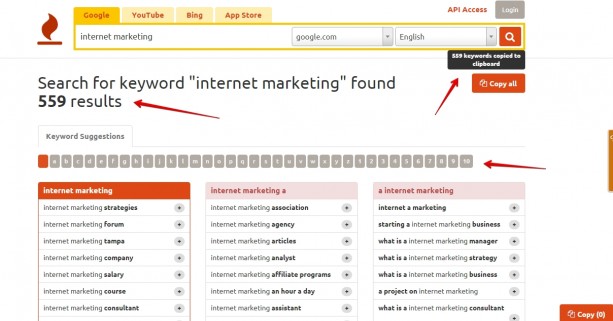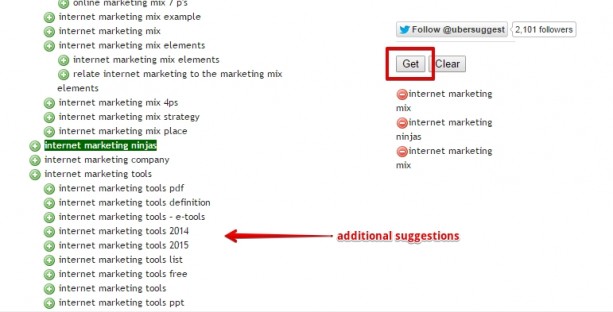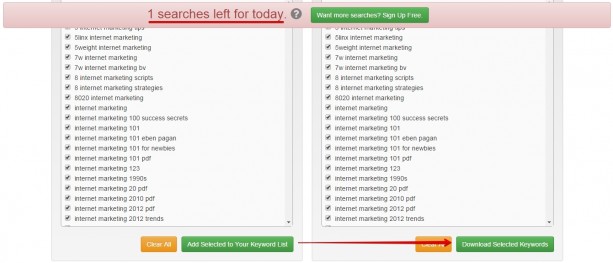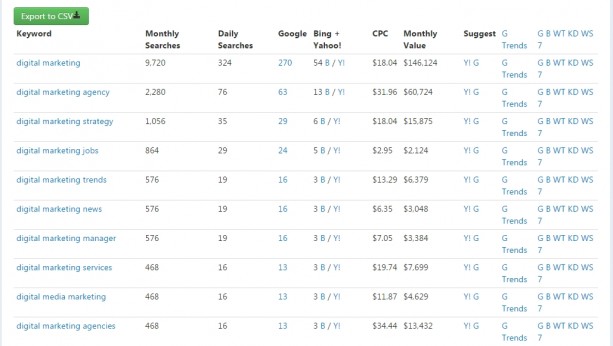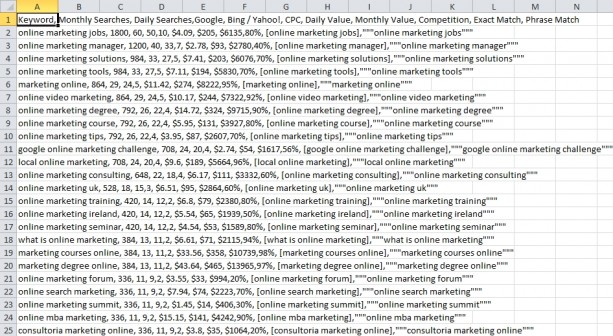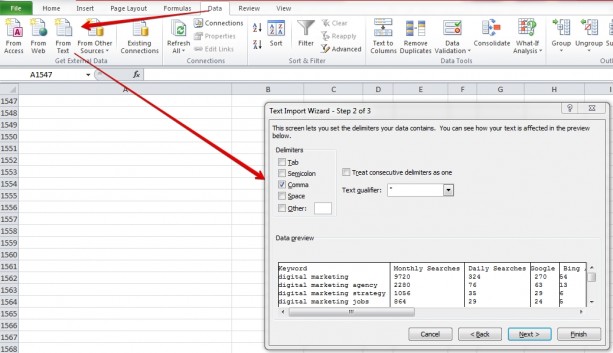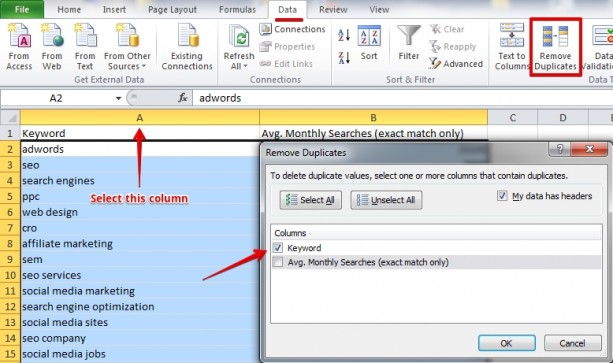Brave yourselves for a long, yet necessary and useful introduction which starts with just one question: what’s the most important thing about promoting a website on Google? Well, there are a lot of factors, but success depends on how much preparation you have done first. A keyword list is the basis for any promotional activities.
So, what is a keyword list? It’s a list of all the possible search queries and combinations thereof that your potential customers may type into a search engine to find your website. I said “all possible queries” for a reason. Let’s define the two types of keyword lists:
- A perfect list – all the queries which exist, even if you can’t find them
- A practical list – all the queries you (or your contractor) managed to collect.
The task is to make a practical list that is as close to a perfect list as possible. Remember that it’s important to make a huge list of keywords. It must cover all your potential customers. It may include thousands or even tens of thousands of queries. It must be global.
Also on TechWyse
Three Easy Steps to Good Keyword Lists
How to Assess the Value of a Keyword
Grow a Long Tail
Sometimes a situation happens when a customer or a contractor wants to focus on, let’s say, 50 keywords. These are very high-frequency and competitive keywords. Imagine you have recently launched an SEO blog. Would it be wise to only promote it with three keywords, such as “SEO”, “SEO blog”, “SEO tips” and so on? I don’t think so and neither do search engines. Just like a keyword list is the basis for promotions, long-tail keywords are the basis for a keyword list. It’s easy to understand:
- High-frequency queries are much more competitive
- You’ll get a high rank for a user who typed in such a query
- Conversion rates of high-frequency queries are lower than those of long-tails’.
You’ll probably disagree with the last point, but let’s make it clear. What do we know about users who searched for “flight tickets”? Nothing. Do they want to buy tickets or just compare prices? Where do they want to fly to? When do they want to fly? What class do they prefer? Queries like “cheap flight tickets to Bangkok May 2015” give us more detailed data, which makes it easier to build a behavioural scenario and reach necessary conversion rates.
One more time: Long-tail Keywords are the Basis.
Of course, it doesn’t mean that you must ignore high-frequency queries. The thing is that you shouldn’t focus on them.
A Few Things to Consider Before Collecting Keywords
You are almost ready to start collecting keywords, but there are some things you must pay attention to:
- Synonyms and jargon. Take synonyms into account when building your KW list. For example, if you want to collect queries based on the term “online marketing”, then don’t forget to collect “internet marketing” and “digital marketing” queries as well.
- Seasonal queries. These are phrases with additions like “May 2015”, “autumn” and so on. Example: “SEO predictions for 2020”.
- Conversional queries. Here the additions are “buy”, “order”, “cost”, “price” etc.
- Regional queries. Queries with a clearly stated region like “SEO agency London”.
- Informational queries. These are queries with “review”, “comparison” and other semantically related additions. Another option is “how to choose <something>” queries.
- Additional queries. <product/service> + <niche/area>. Examples: books for geeks, bicycles for doctors etc.
So, how do you collect them all? Let’s move from theory to practice!
Tools You Should Use
- Google AdWords Keyword Planner
The most obvious option. It provides a list of suggested keywords based on parameters you enter. Go to Keyword Planner (make sure you are logged in your Google account first), then choose “Search for new keyword and ad group ideas”, enter the necessary parameters and click “Get ideas”.
Don’t forget to enter as much data as you can. This is what you’ll come for:
There are two tabs:
- Ad group ideas – a list of categories with keywords combined
- Keyword ideas – actual uncategorised list of keywords
As you can see, you can sort them by several metrics. Try sorting by 'competition' and you’ll find a lot of low-competitive long-tail keywords. What you want to do now is to click the “Download” button right above the “Ad impr. share” column. After downloading a .csv spreadsheet, open and check it. As far as you’re not using AdWords, you can leave only the Keyword column .Got it? Check your spreadsheet and then put it aside – you’ll need it later. Now let’s move on.
- KeywordTool
Another popular keyword research tool. You can find it here. Choose the search engine you are targeting (it’s Google in our case), country, language, and enter a topic. You’ll get a great number of suggested keywords. It’s easy to browse through the list with help of the alphabetic order panel. There is also a button to copy all the suggested keywords, or you can copy the necessary queries manually by pressing the plus buttons at the right.
Unfortunately, it doesn’t provide such insightful data on keywords, but still it’s one of the most popular tools, because it’s easy to use and works pretty effectively. Just copy the necessary keyword (or all of them) and paste them into a spreadsheet from the previous point.
- Ubersuggest
This works almost like Keyword Tool, but with some minor differences. Go here, type a topic, choose a language and a source – this is where differences take place. With Ubersuggest you can choose a source to search for suggestions like web, images and so on.
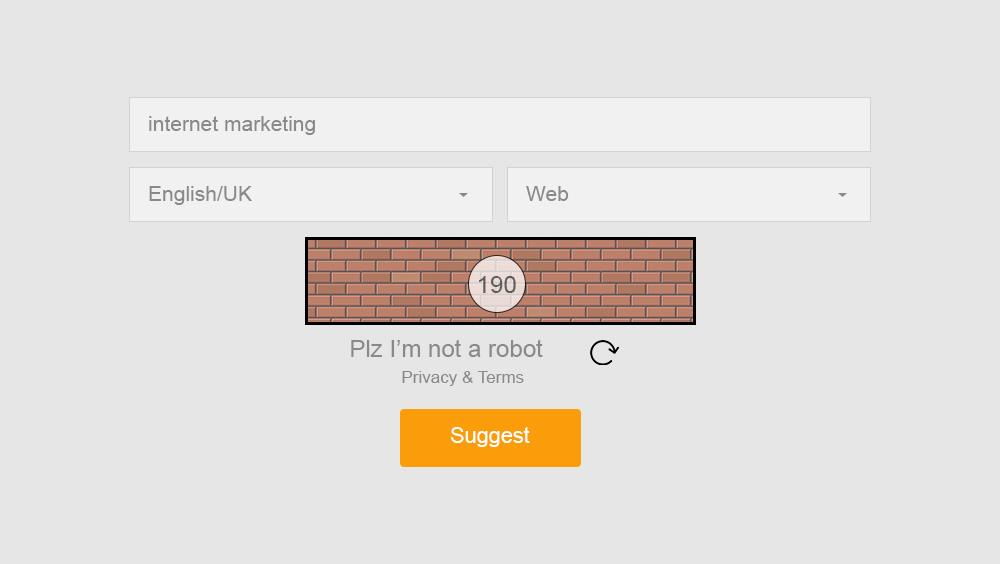
There is another difference, or maybe it’s better to say an additional option – by clicking on suggested keywords you’ll get even more suggestions – you definitely must check out this feature. Have you selected your necessary keywords? Great. Click “Get” at the right and copy & paste them into our spreadsheet.
- Google Autocomplete Keyword Tool by KTD
Simply enter a term and get suggestions. You can use * to make Google fill in the blank. After that, add all the selected keywords to the list and click download. You will get another .csv spreadsheet – copy the data and paste it into the previous one.
You can find it here. It’s a nice tool to collect keywords, but it’s paid for. Free users can only make 3 searches a day. Pricing starts from a $19 one-time payment for 50 searches a day. Is it worth it, if you can use more powerful tools for free? Use it as a secondary tool.
- SEObook Keyword Tool
This tool requires registering with. It’s free and takes less than a minute to do. Enter a basic term and choose the desired options:
- Fuzzy match – use it if you want to get inaccurate matches. However, inaccurate doesn’t mean bad. How does it work? For example, if you submit online marketing term, you’ll also get terms like how to market online or how to market your business online.
- G Trends – by choosing this option you let SEObook get related searches from Google Trends.
- More – choose it, scroll down till the end of a list, and you’ll see a lot of links to SERPs of different engines like Topix.net, Google Blogsearch, Del.icio.us, Twitter, MSN, Reddit and so on. The list is really long.
I recommend choosing Fuzzy match and G Trends for keyword researching purposes – this way you’ll get as many keywords as possible. Choose More if you want to find some additional information on a term.
That’s it. Now click Submit.
Submitting our term and…
Then you can download a list in .csv, but it’s not very convenient – all the data is written in one column. Just look at this:
What you want to do now is to import data from this file to your current, well-organised spreadsheet. Open it, go to Data – From text. Then select a .csv file you’ve downloaded from the SEObook Keyword Tool, click Next (you’ll see that Delimited option is selected by default, it’s ok) and select Comma in the next window. You’ll be shown a preview of the imported data. Click Finish and that’s it – you have successfully imported your data.
Delete all unnecessary columns and you are ready to move on.
Working With a Spreadsheet
Now you have a spreadsheet full of keywords. What should you do next? First of all, you need to remove any duplicated keywords. Open your spreadsheet, choose the Keyword column, go to Data – Remove Duplicates.
Excel will show you how many duplicates were removed.
Now it’s time to clean up your list. Duplicates have already been removed, but there’s still a lot of work to do. Go through the list and check it for irrelevant keywords, keywords in other languages and so on. For example, I found the following inappropriate keywords in my test list:
agencias de internet marketing – other language
brian g jonhson internet marketing – no, that’s not for me; irrelevant
internet marketing Kenya – this isn’t the keyword I’m looking for; irrelevant
How do you find irrelevant keywords? That’s simple. For example, you’re researching keywords for a website that sells furniture building services. Why would you need something concerning furniture which is already built and ready for sale, or keywords like download furniture and free furniture online? Delete them.
What’s the purpose of cleaning your list, if I said that it should contain as many keywords as possible? That’s right, but these keywords should also be as relevant as possible. By including irrelevant keywords, you’ll be getting non-targeted traffic – people who search for turnkey furniture solutions will visit your website, see that it’s not what they were searching for and quit it. As a result, your bounce rate will increase, which significantly hurts your websites ranking.
Final Steps
It’s time to completely reorganise your list. You can work with the current spreadsheet or create a new a new one and copy the data there – use what’s more convenient to you. Create a list of pages you need to promote and create sections for them in a list. Put the pages’ titles in the Keywords column and rename it to “Pages/Keywords”. It looks something like this: you go through the Pages/Keywords column, you see a page’s title (highlight it in yellow to make it more eye catchy) and then comes a list of necessary keywords.
What you want to do next is to add a column for URL's. Add the URL of a page you want to promote for each section’s or page’s name. You still have a free space in the URL column for keywords themselves. Here you can use the following indications if necessary:
- T – a keyword should be written in a title
- D – a keyword should written in a description
- H1 – a keyword should be written in H1 (no surprise)
Look at the screenshot below to make it clearer.
Congratulations, you have collected an awesome list of keywords!
Do’s and Don’ts
After a keyword list is ready, it’s time to learn what you should and should not do:
Do:
- Expand your keyword list monthly
- Include even the longest queries
- Regard keyword research as the basis of your future success
Don’t
- Focus on short and highly competitive keywords
- Throw away keywords that seem irrelevant at first glance – always think one step ahead.
- Use keyword stuffing after finishing your research
Sounds obvious? Indeed, but practice shows that these are the mistakes which beginners make when researching keywords. Follow these simple rules to optimise your keywords experience.
But It Takes too Long!
…you may say. And you’d be right. However, keep in mind that each hour that you spend researching keywords is worth additional profit. The only way to win in highly competitive conditions is to work hard on planning, developing and implementing.




